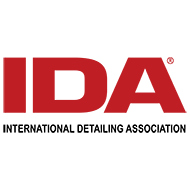IDA Glossary of Detailing Terms
A
- Acid Rain – Rain contaminated with airborne acid materials. Can cause damage to automotive paint finishes and glass.
- Adhesion – How well a product bonds to the surface to which it is applied.
- APC – An abbreviation for all-purpose cleaner.
B
- Base-Coat – The color coat of a base-coat/clear-coat automotive finish. Specifically the layer of pigmented paint applied over the primer coat and usually measures about 1 mil.
- Biodegradable – There is no actual legal definition or universally accepted test for Biodegradability. It commonly refers to organic material generally derived from living matter capable of being broken down into Hydrogen, Carbon Dioxide, and less complex organic compounds through natural forces such as sunlight, bacteria, or enzymes.
- Buffer – A tool used by skilled technicians to apply products to a vehicle. Also referred to as a high-speed buffer or rotary buffer.
- Buffing Compound – A chemical that contains abrasives designed to remove severe oxidation or other major finish imperfections from painted surfaces. Not all buffing compounds are compatible with all paint finishes (such as clear coats) and must be used carefully by skilled technicians.
C
- Ceramic Clear Coat – A paint that contains microscopic ceramic fillers in the formulation that give the clear coat a harder and more durable finish.
- Clear-Coat – A thin transparent layer of paint usually applied over a pigmented layer of paint (base-coat) to provide a deep, rich, shiny finish. Most vehicles have 1.5 to 2.0 mils of clear-coat.
- Compound – An abrasive product designed to remove heavy surface contamination and deep scratches. Can reduce paint thickness quickly. Can leave visible scratches (swirls) in the paint finish.
- Concentrate – A product that requires thinning with an appropriate reducer, water, or solvent.
D
- Dual Action Buffer/Polisher – An electrical or pneumatic tool that has a clutching mechanism attached to the spindle assembly that provides a smooth shifting motion between random orbital and rotary by applying force to the tool.
- Dressed/Dressing – The application of a coating applied to vinyl, leather, plastic, and rubber to protect or make shiny.
E
- Extractor – A machine used to clean carpets and fabric seats. Applies cleaning solution in a spray and removes moisture and dirt by vacuum suction. In car washing, a machine used to spin dry towels.
F
- Fabric Protector – A product applied to cloth seats and carpets that repels moisture, preventing staining.
- Fallout – Contamination which settles out of the air onto automotive paint finishes. Such things as airborne industrial fallout, aircraft fuel, and even volcanic ash.
G
- Glaze – A body shop safe swirl remover or polish. It is considered body shop safe because it contains no wax or silicone.
H
- Haze – When a chemical product such as wax/sealant dries on the surface and appears dull or milky. A dull film caused by imbedded dirt, oxidation, or scratches on the paint surface.
K
- King Ranch Leather – King Ranch leather refers to a type of premium leather associated with the King Ranch, one of the largest ranches in the United States located in South Texas. King Ranch leather is renowned for its high quality and durability, and it is often used in luxury vehicles, particularly trucks and SUVs.The King Ranch leather is typically sourced from the hides of cattle raised on the ranch itself, where they are often bred for their superior quality and durability. The leather is then processed and tanned using traditional methods to maintain its natural characteristics while enhancing its strength and suppleness.
King Ranch leather is known for its distinctive appearance, which often includes natural markings and variations in color that add to its character and authenticity. It is often used in the interiors of vehicles to create a luxurious and rugged aesthetic that reflects the heritage and tradition of the King Ranch.
L
- Lacquer Paint – Any of the various clean or colored synthetic coatings made by dissolving nitrocellulose or other cellulose derivatives together with plasticizers and pigments in a mixture of volatile solvents and used to impart a high gloss to surfaces. Also defined as a glossy, resinous material, such as the exudation of the lacquer tree, used as a surface coating.
- Lacquer Thinner – A highly flammable solvent used to thin lacquer or paints and to clean various items on the vehicle.
M
- Matte Finished Paints – Any paint that leaves a flat, non-shiny finish such as that used on side mirrors, etc.
- Metallic Paint – A type of automotive paint that contains metallic flakes, producing a glittery appearance.
- Mottling – Where the paint appears streaked with light and dark areas. Caused by heavier film thickness in one area over others.
O
- Oil – A viscous liquid mixed of terpene and simple esters or mineral oils, which are mixtures of hydrocarbons, used in paint and auto polishes.
- Orange Peel – The nubby rough appearance on paint; looks much like the texture of an orange peel; surface lacks clarity of reflected image.
- Orbital Buffer – An air or electrical tool with a pad that travels in ellipses instead of rotating on a fixed axis. Used when waxing to simulate the movement of the human hand.
- Original Finish – The paint applied by the manufacturer (O.E.M. finish).
- Overspray – Substance such as paint mist that settles out of the air onto automobile surface, appearing as tiny specks.
- Oxidation – Chemical substances within an automotive finish that collect and bond with oxygen molecules causing the paint to become dry, dull, and faded. Typical of single-stage paint finishes.
P
- Paint Film Thickness – The measure of the amount of film on the vehicle. Measured in mils, which is thousandths of an inch.
- Paint Sealant – A protective product applied by hand or machine to automotive paint, which coats, seals, and protects the surface.
- Polish – A chemical formulated to produce a smooth, bright, and glossy paint surface. It can also remove swirl marks. Can also be called a swirl remover.
- Polishing – Term often used to describe the action of a rotary or dual action buffer to remove swirls and/or smooth the paint to a high gloss finish.
- Polisher – Another name for a rotary or dual action buffer.
- Polishing Pad – A sheepskin or foam pad that is used with a rotary or dual action buffer to remove swirls or smooth the paint.
- Pressure Washer – A machine that uses a piston pump to increase water pressure to a psi of 500 to over 3,000. Used to clear engines/wheels and wash and rinse vehicles.
- Prewash – First step in preparing a vehicle for detailing, by removing dirt, tar, etc.
- Primer – Material applied to the surface to seal, fill scratches, and improve adhesion of paint.
R
- Rail Dust – Small metallic particles that can settle on the horizontal surfaces of automobiles and become embedded in the paint. As the particles oxidize/rust they appear as orange specks on the paint. Requires special products and procedures to be removed. Also known as industrial fallout.
S
- Sealer/Sealant – A paint protection chemical applied by hand or machine to an automotive paint that coats, seals, and protects the surface. Normally contains amino-functional silicones to increase durability.
- Shine – To brighten or increase luster of a paint finish.
- Silicone – Any group of polymerized semi-organic compounds comprised of silicone items, oxygen, and possibly organic compounds. Characterized by high resistance to heat and water. Silicone adds durability, lubricity and enhances gloss. Silicone can create complications during repainting in body shops. Non-silicone products are preferable for body shop applications.
- Surfactant – A compound that helps lift substances from a surface so they may be removed. Usually found in cleaners to improve rinsing.
- Swirls – Micro-scratches in the paint surface caused by too abrasive a buffing pad, compound, or faulty buffing technique.
T
- Transit Coating – A protective coating applied to auto exteriors prior to transportation to prevent damage to the exterior surfaces. Requires special chemicals and removal procedures.
U
- Ultraviolet Rays – A component of ordinary light which cannot be seen by the human eye. Deteriorates automotive surfaces by causing fading, cracking, peeling and discoloration. They can also wreak havoc on PPF, wraps, and interior surfaces. Some products contain ingredients that guard against UV damage.
V
- Vapor Steamer – A device that uses a small boiler to generate steam up to 200 degrees+ that is then used to perform a number of cleaning functions, including sanitization.
- Vegetable Tanned Leather – Vegetable-tanned leather, often abbreviated as veg-tan leather, is a type of leather that is tanned using tannins extracted from vegetable matter such as tree bark, leaves, and fruit. This traditional method of tanning has been practiced for centuries and is known for producing durable and high-quality leather. The process of vegetable tanning involves soaking animal hides in a series of baths containing tannins. The tannins penetrate the fibers of the hide, causing it to become more rigid and resistant to decay. This results in leather that is firm, yet flexible, with a natural appearance and a characteristic aroma.
Vegetable-tanned leather can be found in some super cars, where a fine pigmentation is applied over the top. Additionally, vegetable-tanned leather is often preferred by those seeking a more environmentally friendly alternative to chrome-tanned leather, which utilizes chemicals that can have harmful environmental impacts.
W
- Waterless Wash – A natural or synthetic element used in chemicals to protect the paint by physically bonding with the paint (i.e., carnauba wax).
- Wax – A natural or synthetic element used in chemicals to protect the paint (e.g., carnauba wax).
- Weathering – The negative change or failure in paint caused by exposure to weather.
- Wet Sanding – A procedure of simultaneously sanding and rinsing an automotive finish to smooth the paint, thus removing imperfections. Regarded as complicated and should only be attempted by professionals.


